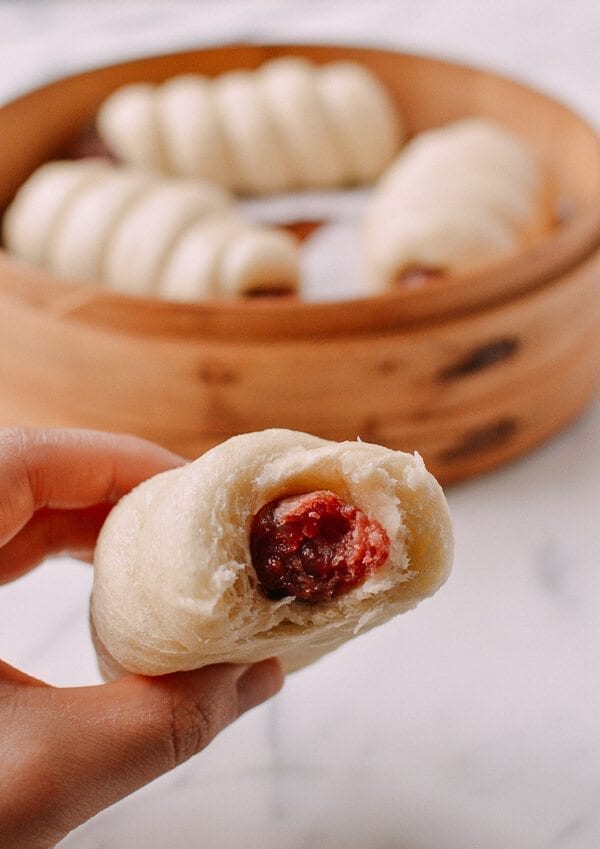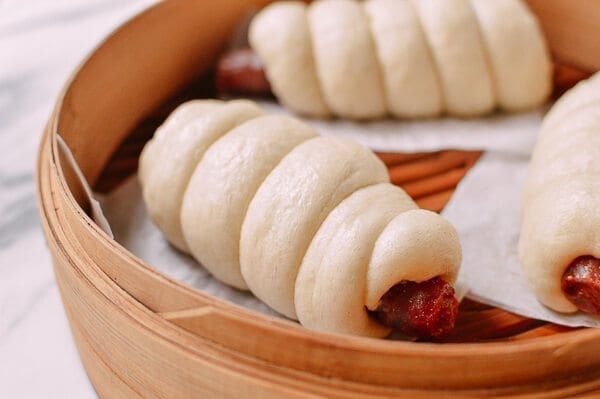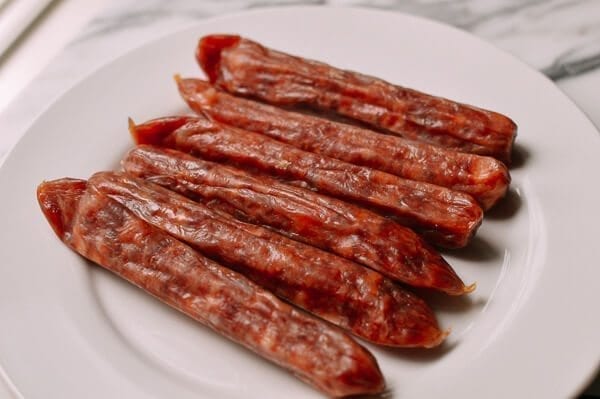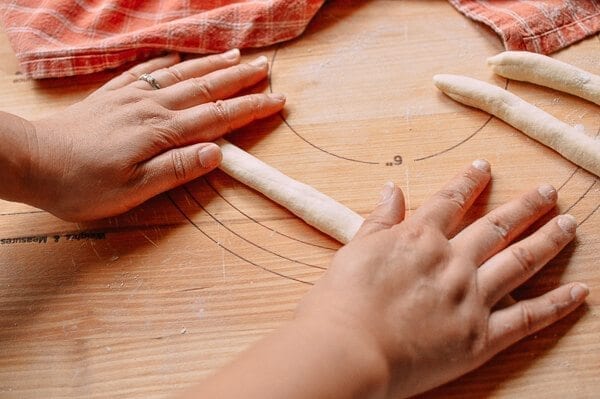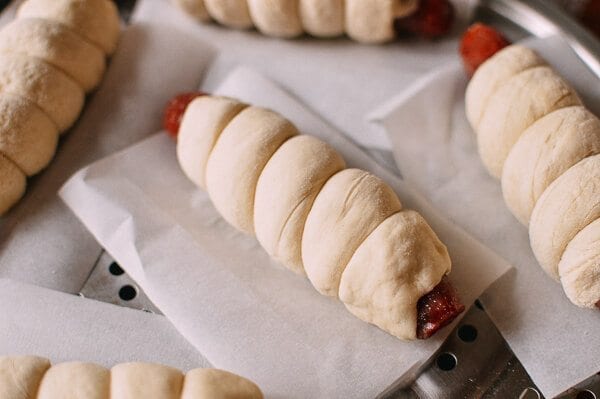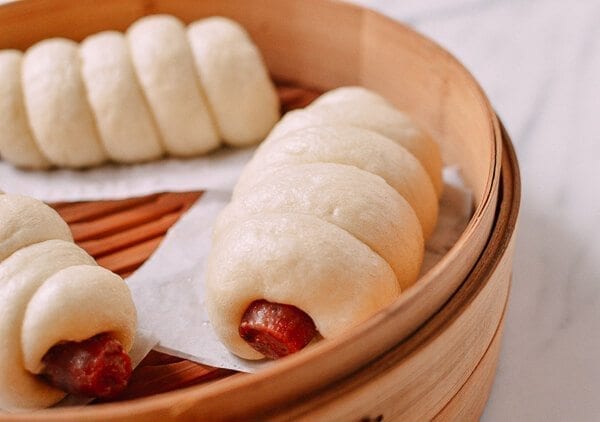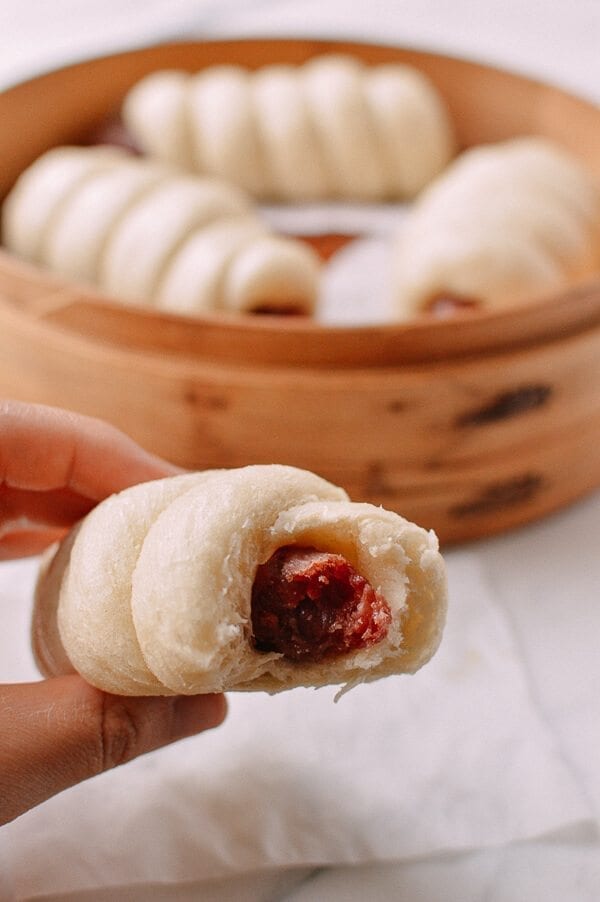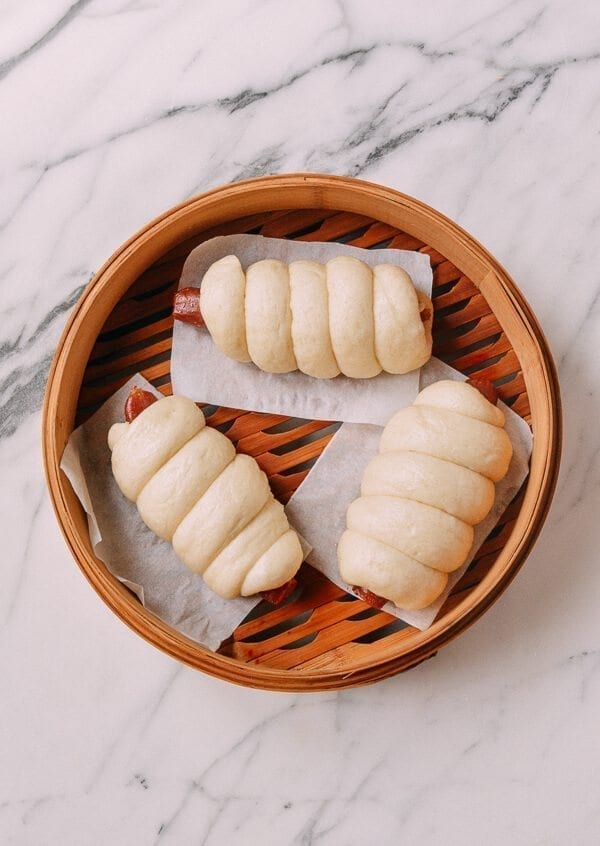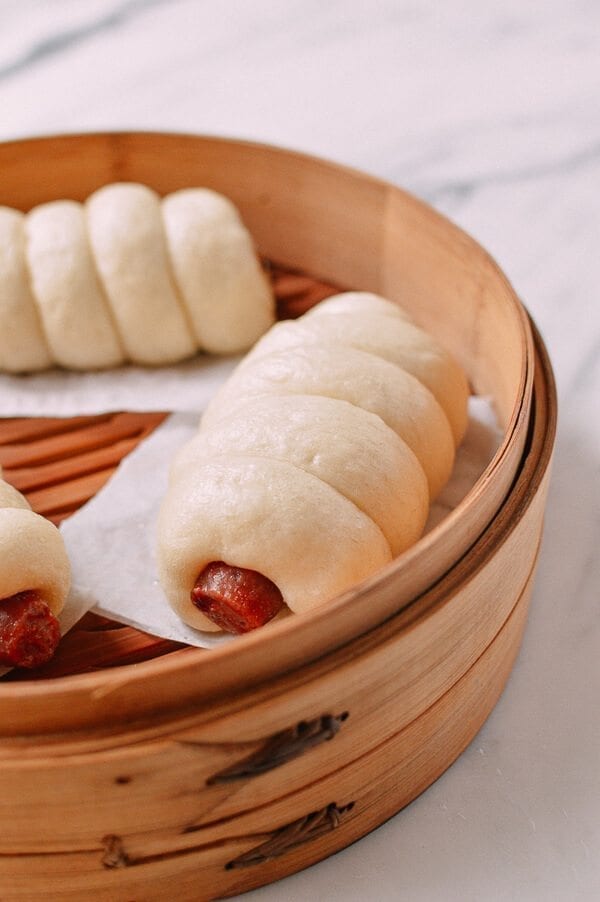These Chinese Sausage Buns (Lop Cheung Bao) are a tasty throwback treat that you seldom see anymore. Chinese Sausage Buns are made with fluffy steamed mantou, with a satisfyingly savory and salty link of cured Chinese sausage at the core of each bun. It’s the very delicious and very Chinese cousin of the beloved Chinese Hot Dog Bun.
A Rarely Seen Treat
Chinese Sausage Buns are one of the many old-school favorites that have fallen out of popularity, rarely (if ever, these days) making an appearance in dim sum houses and Chinese bakeries. I’m not sure why this is the case. Too rich and fatty? Are they a hassle for restaurants and bakeries to keep fresh? Are margins too low? Are lop cheung Chinese sausages no longer a crowd-pleaser?
Whatever the reason, these buns have become so rare, that the last time I think I had one of these may have been in my childhood days growing up in upstate New York.
Many of you have thanked us for sharing our recipes, but I think it’s time that we thank all of you readers and home cooks for your recipe requests and for helping us unearth our own forgotten favorite foods and recipes. Even though I love Chinese sausage, I probably would not have thought to make these Lop Cheung Bao if we did not have this blog and so many faithful readers!
Personally, I don’t know why these Chinese sausage buns aren’t everywhere now that we’re headed into the colder months. It’s the kind of hearty snack you’d welcome after a couple hours of raking leaves on a brisk fall day, after shoveling snow on a wintry morning, or even for a halftime snack on a lazy Sunday afternoon of watching football.
Chinese Sausage Buns are not only delicious, they are also very convenient to freeze and reheat. Simply let the steamed buns cool completely after preparation and freeze them for an anytime snack or after-school meal for kids. Simply place them on the steamer rack right out of the freezer and steam them for about 10 minutes.
When we tasted these, fresh from the steamer, we had no idea why we had waited so long to revive this old favorite. Make these! If you grew up with them, you won’t regret it.
Recipe Instructions
In a small bowl, whisk together the water, yeast and sugar until the yeast dissolves. Let the mixture sit until the yeast “blooms” and foams (about 15 minutes). Stir in 1 tablespoon oil and set aside.
Whisk together the flour, cornstarch, salt, and baking soda in a medium-sized bowl, and stir in the yeast mixture using a spatula. After the dry and wet ingredients are incorporated, knead the dough with your hands until the dough becomes smooth and soft. If the dough looks sticky , add a bit more flour 1 tablespoon at a time, and continue kneading until the dough is smooth and soft. The dough should be soft, but not sticky.
Coat the dough with 1 teaspoon of oil and cover with plastic wrap. Let the dough proof at room temperature until it has doubled in size (about 1 hour).
While the dough is proofing, prepare your steaming device/setup of choice. (Check our Chinese cooking tools page for steamer setup options using a steamer rack in a wok or a multi-level metal steamer, both of which we use regularly in our kitchen.) Place the lop cheung (Chinese sausages) on a heatproof plate and steam for 10 minutes. Let cool.
For this recipe, we called for a whole lop cheung in each bun, but if you feel this is too much, just split them lengthwise after they’ve steamed and cooled and use half a Chinese sausage for each bun!
After the dough is finished proofing, punch the dough down and knead it for a few minutes to get rid of all the air bubbles. Portion the dough into 10 equal balls and shape each ball into a long strip, measuring 10 inches long.
Wrap each length of dough around one lop cheung so the dough overlaps. Tuck in the loose ends. This is the same method used in our recipe for Chinese Hot Dog Buns.
Place each bun on one of your prepared rectangles of parchment paper, and place the buns into your steamer. Cover with a damp kitchen towel to keep the dough from drying out, and let rest for 20 minutes.
Place the buns in your metal or bamboo steamer with 1½ inches of cold water, and turn the heat on high. Once you can see steam coming out, turn the heat down to medium, and let the buns steam for another 10 minutes until they have expanded in size. See our post on how to set up a steamer if you’re not familiar with steaming foods in Chinese cooking.
Remove the steamer from the stove. Let your Chinese sausage buns rest inside the steamer for 5 minutes–Do NOT remove the cover. This is an important step, because if you remove the cover too early, the buns will collapse and lose their fluffy shape!
After those five minutes have elapsed, transfer your lop cheung baos to a plate and serve warm!
These Chinese sausage buns freeze and reheat really nicely. Make sure you steam the buns and let them cool completely before freezing. Reheat by placing the frozen buns into a steamer, and steaming for about 10 minutes.
Chinese Sausage Buns (Lop Cheung Bao)
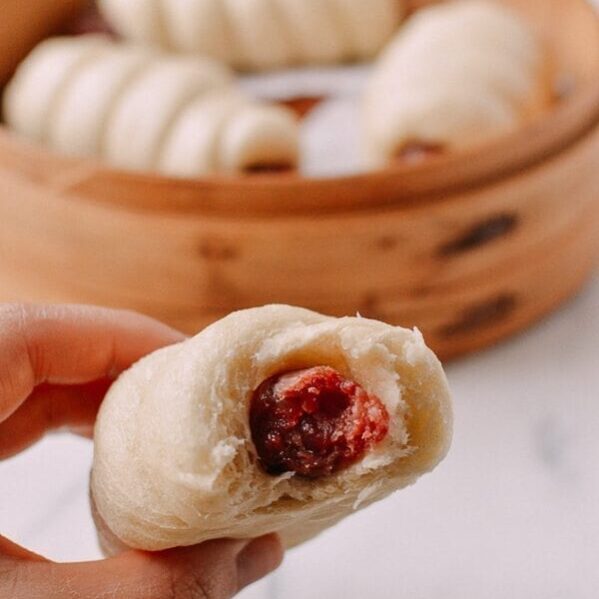
Ingredients
- 3/4 cup warm water
- 1 teaspoon instant yeast
- 1 tablespoon granulated sugar
- 1 tablespoon canola oil (plus 1 teaspoon)
- 2 cups all purpose flour (you can use bleached flour if you like)
- 2 tablespoons cornstarch
- ¼ teaspoon salt
- 1/8 teaspoon baking soda
- 10 Chinese sausages (lop cheung)
Instructions
- In a small bowl, whisk together the water, yeast and sugar until the yeast dissolves. Let the mixture sit until the yeast “blooms” and foams (about 15 minutes). Stir in 1 tablespoon oil and set aside.
- Whisk together the flour, cornstarch, salt, and baking soda in a medium-sized bowl, and stir in the yeast mixture using a spatula. After the dry and wet ingredients are incorporated, knead the dough with your hands (or in your mixer) until the dough becomes smooth and soft. If the dough looks sticky, add a bit more flour 1 tablespoon at a time, and continue kneading until the dough is smooth and soft. The dough should be soft, but not sticky.
- Coat the dough with 1 teaspoon of oil and cover with plastic wrap. Let the dough proof at room temperature until it has doubled in size (about 1 hour).
- While the dough is proofing, prepare your steaming device/setup of choice. (Check our Chinese cooking tools page for steamer setup options using a steamer rack in a wok or a multi-level metal steamer, both of which we use regularly in our kitchen.) Place the lop cheung (Chinese sausages) on a heatproof plate and steam for 10 minutes. Let cool.
- For this recipe, we called for a whole lop cheung in each bun, but if you feel this is too much, just split them lengthwise after they’ve steamed and cooled and use half a chinese sausage for each bun!
- After the dough is finished proofing, punch the dough down and knead it for a few minutes to get rid of all the air bubbles. Portion the dough into 10 equal balls and shape each ball into a long strip, measuring 10 inches long. Wrap each length of dough around one lop cheung so the dough overlaps. Tuck in the loose ends. This is the same method used in our recipe for Chinese Hot Dog Buns.
- Place each bun on one of your prepared rectangles of parchment paper, and place the buns into your steamer. Cover with a damp kitchen towel to keep the dough from drying out, and let rest for 20 minutes.
- Place the buns in the steamer with 1½ inches of cold water, and turn the heat on high. Once you can see steam coming out, turn the heat down to medium, and let the buns steam for another 10 minutes until they have expanded in size.
- Remove the steamer from the stove. Let the buns rest inside the steamer for 5 minutes--do not remove the cover. This is an important step, because if you remove the cover too early, the buns will collapse and lose their fluffy shape!
- After those five minutes have elapsed, transfer the buns to a plate and serve warm!
- These Chinese sausage buns freeze and reheat really nicely. Make sure you steam the buns and let them cool completely before freezing. Reheat by placing the frozen buns into a steamer, and steaming for about 10 minutes.
